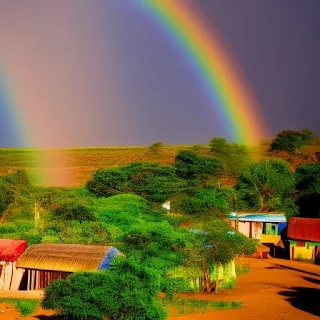African Spiritual Significance of Rainbows
Rainbows hold spiritual significance that transcends cultures and religions. In numerous regions of Africa, rainbows are believed to convey messages to loved ones who have passed away.
Many African cultures believe that rainbows can carry messages from loved ones who have passed away or that seeing a rainbow is a sign of good luck or blessings to come.
In the Bible, a rainbow is a sign of God's promise to never again flood the earth. In Hinduism, rainbows are seen as a bridge between the physical and spiritual realms. In some Native American cultures, rainbows are associated with the Great Spirit and represent the unity of all living things.
Rainbows hold different meanings in different cultures across Africa.
In many South African cultures, rainbows are seen as a sign of good luck and prosperity. They are also believed to be a bridge between the spiritual and physical realms. In Ghana, rainbows are associated with Anansi, a spider trickster from Ashanti folklore. Anansi is believed to use rainbows as a ladder to climb to the sky and visit the gods.
In ancient Egyptian mythology, the rainbow symbolized the goddess Isis, who was associated with fertility, rebirth, and the afterlife. In some Nigerian cultures, rainbows are believed to be the bridge between the human world and the world of spirits. They are also seen as a symbol of hope and promise and are sometimes associated with the deity Olokun, the god of the ocean.
Rainbows are generally viewed positively across Africa and are often seen as a symbol of good luck, hope, and connection between different worlds. There are several places in Africa where you can see rainbows, depending on the weather conditions and time of day.
Some of the best places to see rainbows are in Africa.
Victoria Falls in Zimbabwe, the mist from the falls creates ideal conditions for rainbows to form, and the early morning or late afternoon sun provides the best lighting.
In Cape Town, South Africa, the combination of the Atlantic and Indian Oceans and the region's mountainous terrain can produce beautiful rainbows, especially during winter.
The sand dunes of Sossusvlei can create stunning rainbows during the rainy season, typically lasting from January to April.
The clear, calm waters of Lake Malawi can create perfect conditions for rainbows to form, especially during the rainy season from November to April.
Mount Kilimanjaro, Tanzania: The area's high altitude and frequent rainfall can produce beautiful rainbows on Mount Kilimanjaro in Tanzania, especially in the early morning or late afternoon.
Sun, Rain, and Rainbows Relationship.
A rainbow is a beautiful and colorful arc that appears in the sky after it rains. It comprises seven colors: red, orange, yellow, green, blue, indigo, and violet. From top to bottom, the colors of a rainbow are red, orange, yellow, green, blue, indigo, and violet (often remembered with the acronym ROYGBIV). Each color has a specific wavelength, creating the white light we see when combined. These colors blend into each other seamlessly and create a beautiful display of nature.
Rainbows happen because of the sun and the rain. When sunlight shines on water droplets in the air, it gets refracted or bent and split into different colors. When the light enters the water droplet, it bends and separates into the colors that make up a rainbow. Sometimes, a second, fainter rainbow can be seen outside the primary rainbow. This is known as a double rainbow; its colors appear in reverse order compared to the primary rainbow.
The shape of a rainbow is always in an arc.
The shape of a rainbow is always in an arc because of how light is refracted and reflected within raindrops. When sunlight passes through a raindrop, it undergoes refraction, which means the light changes direction as it enters the water droplet. The different colors of light (each with its own wavelength) bend at slightly different angles due to their varying wavelengths.
As the light continues to travel inside the raindrop, it undergoes multiple internal reflections off the inner surface of the droplet. These reflections cause the light to bounce around within the droplet and further separate into its constituent colors. Finally, as the light exits the raindrop, it undergoes another refraction, bending again as it passes from the water droplet back into the air. The angle at which the light is refracted depends on its wavelength.
The combination of these processes; refraction, reflection, and refraction again—causes the dispersed colors of light to form a circular arc in the sky. The center of this arc is directly opposite the sun in the sky, with the observer seeing the top of the arc higher than the horizon.
The shape is an arc and not a full circle because the light can only be observed within a specific range of angles. As the angles get larger, the light is spread out too widely to be visible to the human eye. Therefore, only a portion of the circular arc is visible, resulting in the classic semi-circular shape of a rainbow. So, the arc shape of rainbow results from the way light interacts with raindrops and the limitations of our perception.
So the next time you see a rainbow, remember that it's a beautiful and magical display of nature that happens when sunlight and raindrops come together just the right way. While rainbows are most commonly seen after rain, they can also be observed near waterfalls, fountains, or even from the spray of garden hoses under the right conditions.
Learn how to increase your chances of witnessing a rainbow.
Rainbows are a natural occurrence caused by specific weather conditions; however, you can do a few things to enhance your chances of witnessing a rainbow.
Find the right conditions: Look for a combination of rain and sunshine. Ideally, you want light rain or drizzle while the sun still shines or shortly after a rain shower.
Position yourself: Stand with your back to the sun and face the area where the rain falls. This increases your chances of seeing the rainbow in the opposite direction of the sun.
Look for water sources: Rainbows can also appear near waterfalls, fountains, or even from a garden hose spray. These water sources can create the necessary conditions for a rainbow to form.
Patience and observation: Keep an eye on the sky and be patient. Rainbows are not always immediately visible and can appear and disappear quickly. Stay observant and watch for any signs of a rainbow forming.
While you cannot physically create a rainbow, positioning yourself in the right place and being aware of the weather conditions can maximize your chances of witnessing this beautiful natural phenomenon.
Did you know that rainbows are thought to carry special messages to our loved ones who have passed away? It's a beautiful way to believe that our departed friends and family are still watching over us, always present in their own unique way.
- Dangerous Erupting Volcanoes of Africa

- Top 20 Largest Countries in Africa

-
What is an African Proverb

- African Water Spirit Mami Wata

-
Ancestors are Guardian Angels










